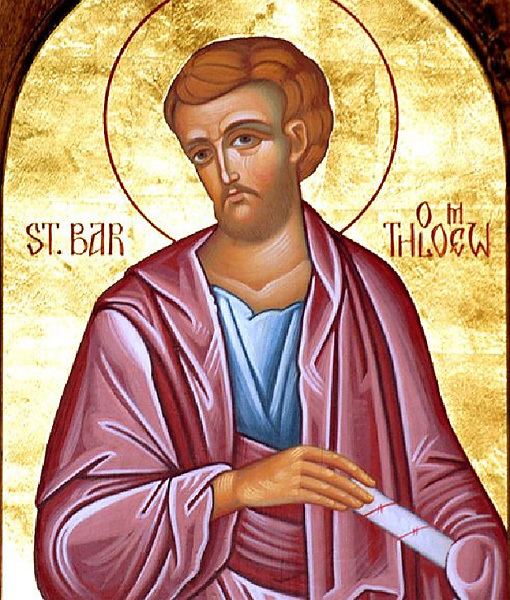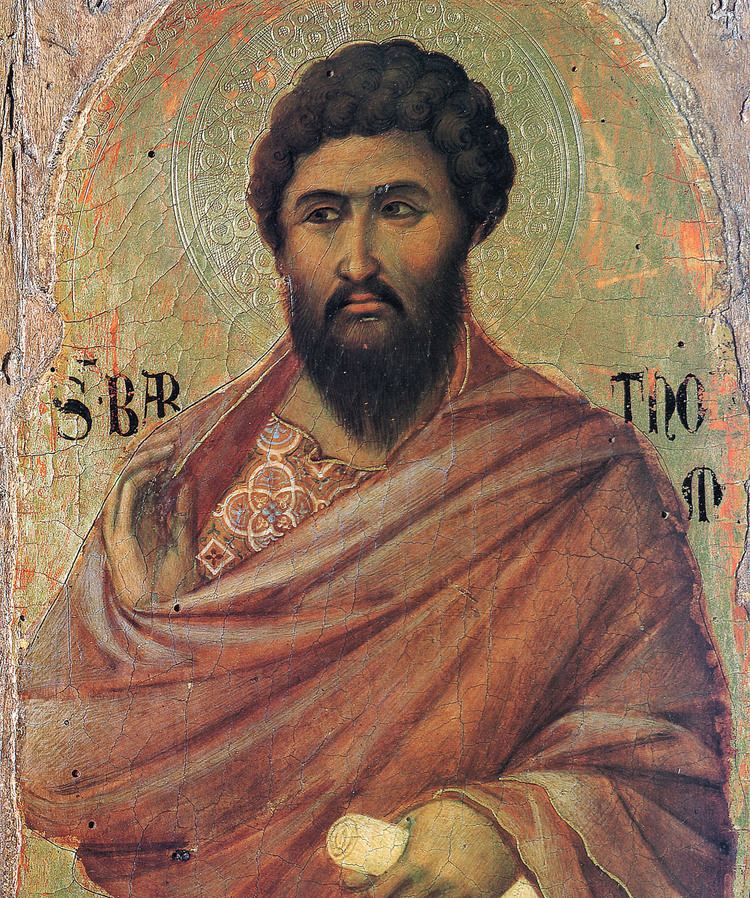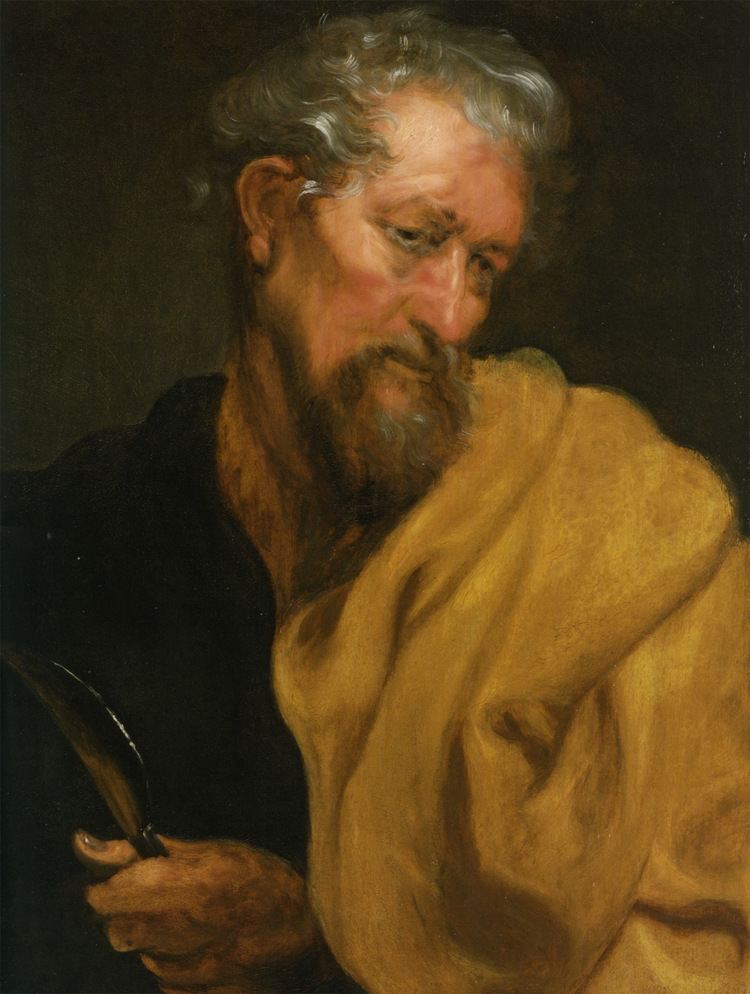Name Bartholomew Apostle Died Armenia | Full name Bartholomew of Iudaea | |
 | ||
Venerated in Assyrian Church of the EastRoman Catholic ChurchMaronite Catholic ChurchEastern Orthodox ChurchOriental OrthodoxyAnglican CommunionLutheran ChurchIslam (named in Muslim exegesis as one of the disciples) Major shrine Saint Bartholomew Monastery in historical Armenia, Relics at Saint Bartholomew-on-the-Tiber Church, Rome, the Canterbury Cathedral, the Cathedral in Frankfurt, and the San Bartolomeo Cathedral in Lipari Patronage Armenia; bookbinders; butchers; Florentine cheese and salt merchants; Gambatesa, Italy; Catbalogan, Samar; Gharghur, Malta; leather workers; neurological diseases; plasterers; shoemakers; curriers; tanners; trappers; twitching; whiteners ; Los Cerricos (Spain) Similar People | ||
Discovering our Saints - St. Bartholomew the Apostle
Bartholomew (Greek: Βαρθολομαῖος Bartholomaíos, Latin: Bartholomaeus) was one of the Twelve Apostles of Jesus. He has been identified with Nathanael (alternatively spelled Nathaniel), who appears in the Gospel according to John as being introduced to Christ by Philip (who would also become an apostle),[Jn 1:43-51] although some modern commentators reject the identification of Nathanael with Bartholomew.
Contents
- Discovering our Saints St Bartholomew the Apostle
- Tradition
- Mission to India
- In Armenia
- Bartholomews relics
- Miracles
- Art and literature
- Culture
- References

According to the Synaxarium of the Coptic Orthodox Church, his martyrdom is commemorated on the first day of the Coptic Calendar (i.e. the first day of the month of Thout), which currently falls on September 11 (corresponding to August 29 in the Julian Calendar). His feast is June 11 in Eastern Christianity and August 24 in the Lutheran Church–Missouri Synod, Anglican Communion and both forms of the Roman Rite of the Catholic Church.

Bartholomew (Greek: Βαρθολομαῖος, transliterated "Bartholomaios") comes from the Aramaic {bar-Tôlmay (בר-תולמי),} meaning son of Talmai or son of the furrows (perhaps a ploughman). Bartholomew is listed among the Twelve Apostles of Jesus in the three Synoptic gospels: Matthew,[10:1–4] Mark,[3:13–19] and Luke,[6:12–16] and also appears as one of the witnesses of the Ascension[Acts 1:4,12,13]; on each occasion, however, he is named in the company of Philip. He is not mentioned by the name Bartholomew in the Gospel of John, nor are there any early acta, the earliest being written by a pseudepigraphical writer who assumed the identity of Abdias of Babylon and to whom is attributed the Saint-Thierry Manuscript and Pseudo-Abdias Manuscripts.

Tradition

Eusebius of Caesarea's Ecclesiastical History (5:10) states that after the Ascension, Bartholomew went on a missionary tour to India, where he left behind a copy of the Gospel of Matthew. Other traditions record him as serving as a missionary in Ethiopia, Mesopotamia, Parthia, and Lycaonia. Popular traditions and legends say that Bartholomew preached the Gospel in India, then went to Greater Armenia.
Mission to India

Two ancient testimonies exist about the mission of Saint Bartholomew in India. These are of Eusebius of Caesarea (early 4th century) and of Saint Jerome (late 4th century). Both of these refer to this tradition while speaking of the reported visit of Pantaenus to India in the 2nd century. The studies of Fr A.C. Perumalil SJ and Moraes hold that the Bombay region on the Konkan coast, a region which may have been known as the ancient city Kalyan, was the field of Saint Bartholomew's missionary activities.
In Armenia
Along with his fellow apostle Jude Thaddeus, Bartholomew is reputed to have brought Christianity to Armenia in the 1st century. Thus, both saints are considered the patron saints of the Armenian Apostolic Church.
He is said to have been martyred in Albanopolis in Armenia. According to one account, he was beheaded, but a more popular tradition holds that he was flayed alive and crucified, head downward. He is said to have converted Polymius, the king of Armenia, to Christianity. Astyages, Polymius' brother, consequently ordered Bartholomew's execution.
The 13th century Saint Bartholomew Monastery was a prominent Armenian monastery constructed at the site of the martyrdom of Apostle Bartholomew in the Vaspurakan Province of Greater Armenia (now in southeastern Turkey).
Bartholomew's relics
The 6th-century writer in Constantinople, Theodorus Lector, averred that in about 507 Emperor Anastasius gave the body of Bartholomew to the city of Dura-Europos, which he had recently re-founded. The existence of relics at Lipari, a small island off the coast of Sicily, in the part of Italy controlled from Constantinople, was explained by Gregory of Tours by his body having miraculously washed up there: a large piece of his skin and many bones that were kept in the Cathedral of St Bartholomew the Apostle, Lipari, were translated to Benevento in 838, where they are still kept now in Basilica of San Bartolomeo. A small part of the relics was given in 983 by Holy Roman Emperor Otto II to Rome where it is conserved at the basilica of San Bartolomeo all'Isola. In time, the church there inherited an old pagan medical centre. This association with medicine in course of time caused Bartholomew's name to become associated with medicine and hospitals. Some of Bartholomew's alleged skull was transferred to the Frankfurt Cathedral, while an arm was venerated in Canterbury Cathedral.
Miracles
Of the many miracles claimed to have been performed by Bartholomew before and after his death, two very popular ones are known by the townsfolk of the small island of Lipari.
The people of Lipari celebrated his feast day annually. The tradition of the people was to take the solid silver and gold statue from inside the Cathedral of St Bartholomew and carry it through the town. On one occasion, when taking the statue down the hill towards the town, it suddenly became very heavy and had to be set down. When the men carrying the statue regained their strength, they lifted it a second time. After another few seconds, it got even heavier. They set it down and attempted once more to pick it up. They managed to lift it but had to put it down one last time. Within seconds, walls further downhill collapsed. If the statue had been able to be lifted, all the townspeople would have been killed.
During World War II, the Fascist regime looked for ways to finance their activities. The order was given to take the silver statue of Saint Bartholomew and melt it down. The statue was weighed, and it was found to be only a few grams. It was returned to its place in the Cathedral of Lipari. In reality, the statue is made from many kilograms of silver and it is considered a miracle that it was not melted down.
Saint Bartholomew is credited with many other miracles having to do with the weight of objects.
Art and literature
Christian tradition has three stories about Bartholomew's death: "One speaks of his being kidnapped, beaten unconscious, and cast into the sea to drown. Another account states that he was crucified upside down, and another says that he was skinned alive and beheaded in Albac or Albanopolis", near Başkale, Turkey.
The account of Bartholomew being skinned alive is the most represented in works of art, and consequently Bartholomew is often shown with a large knife, holding his own skin (as in Michelangelo's Last Judgment), or both. In Avezzano, in Abruzzo the image of the Saint who is holding his own skin has become the symbol of the city. Archaeological research has shown that the cult of Saint Bartholomew began in Avezzano, because the previous presence of a temple dedicated to Heracles, which is always represented in the act of holding the skin of the Nemean Lion. There is, therefore, a solid relationship between the two iconographies and the re-semantization of the symbols Heracles/Physical Strength/Hero and Bartholomew/Power of Faith/Hero-Martyr. Bartholomew is also the patron saint of tanners.
Bartholomew plays a part in Francis Bacon's Utopian tale New Atlantis, about a mythical isolated land, Bensalem, populated by a people dedicated to reason and natural philosophy. Some twenty years after the ascension of Christ the people of Bensalem found an ark floating off their shore. The ark contained a letter as well as the books of the Old and New Testaments. The letter was from Bartholomew the Apostle and declared that an angel told him to set the ark and its contents afloat. Thus the scientists of Bensalem received the revelation of the Word of God.
In recent days especially, depictions of the saint have found daunting new forms, such as Damien Hirst's bronze statue (2006) or the large-scale painting by Aris Kalaizis, created in confrontation with the relic and the depictions of Saint Bartholomew at Frankfurt Cathedral.
Culture
The festival in August has been a traditional occasion for markets and fairs, such as the Bartholomew Fair held in Smithfield, London since the Middle Ages, which served as the scene for Ben Jonson's homonymous comedy.
"St Bartholomew's Street Fair" is held in Crewkerne, Somerset annually at the start of September. The fair dates back to Saxon times and the major traders market was recorded in the Domesday Book. St Bartholomew's Street Fair, Crewkerne is reputed to have been granted its charter in the time of Henry III (1207–1272). The earliest surviving court record was made in 1280, which can be found in The British Museum. The associated fun fair dates from at least 1861.
